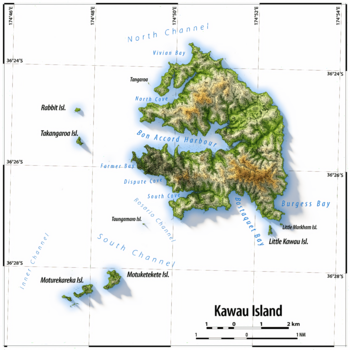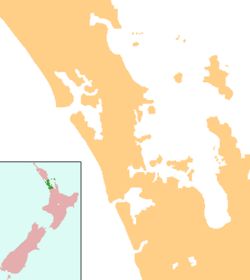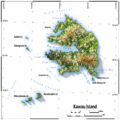Kawau Island facts for kids
Kawau Island is a special place in the Hauraki Gulf, located near the north-eastern coast of New Zealand's North Island. It's about 1.4 kilometres (0.9 miles) from the mainland at its closest point. The island is also about 8 kilometres (5 miles) by sea from Sandspit Wharf, and 40 kilometres (25 miles) north of Auckland.
Most homes on Kawau Island can only be reached by sea. There are only two short roads on the island. Many residents have their own private wharves right at their front doors!
The island's name, Kawau, comes from the Māori language word for the shag, a type of bird.
You can get to Kawau Island by a regular ferry service or water taxis. These services operate from Sandspit Wharf on the mainland.
Contents
Exploring Kawau Island's Geography
Kawau Island is about 8 kilometres (5 miles) long and 5 kilometres (3 miles) wide. It's almost cut in half by a long bay called Bon Accord Harbour. This harbour is a "drowned valley," meaning it was once a valley on land that later filled with seawater.
This sheltered bay is a popular spot for yachts and boats. The island itself is mostly made of greywacke rocks and small lava flows. These rocks formed on the seafloor a long time ago. Then, the island was pushed upwards by natural forces. Some of the lava flows had hot springs nearby. These springs left behind minerals like iron, manganese, and copper.
About 17,000 years ago, during the last Ice Age, sea levels were much lower. At that time, Kawau Island was connected to the North Island. The area where the Hauraki Gulf is now was a large coastal plain. Around 7,000 years ago, sea levels started to rise. This is when Kawau became an island, separated from the rest of New Zealand.
Kawau Island's Rich History
Even though Kawau Island didn't have much land for farming, Māori people loved its beautiful surrounding waters. Battles over the island were common from the 1600s onwards. Old stories say that an ancestor named Toi-te-huatahi called the island Te Kawau Tu Maro. This means "the shag standing watch."
For many generations, Māori tribes like Te Kawerau ā Maki and Ngāi Tai ki Tāmaki lived on Kawau. There's a defensive fort, called a pā, named Momona on the island. It's located near where the Mansion House stands today.
Copper Mining on Kawau Island
In 1840, some business people from New South Wales bought the island. Soon after, a company called the Kawau Company started mining copper there. Miners from Cornwall, England, came to work on the island. Later, smelters from Wales joined them. Smelting is the process of melting ore to get the metal out. They built a smelting operation on the island because shipping raw ore was a fire risk.
The island became very important for copper. In 1844-1845, Kawau Island produced about 7,000 pounds of copper. This was a big deal, making up about a third of Auckland's exports that year.
Sir George Grey and Mansion House
A few years later, in 1862, Sir George Grey bought the island. He was the Governor of New Zealand at the time. Sir George wanted Kawau Island as his private getaway. He made the original copper mine manager's house bigger, creating the famous Mansion House. This historic house is still standing today.
Sir George also turned the land around Mansion House into a special park. He brought in many different plants and animals from other parts of the world. After Sir George Grey, the house changed owners many times and started to fall apart. But it has since been restored to how it looked when Governor Grey lived there.
Today, Mansion House is part of the Kawau Island Historic Reserve. This reserve is public land and covers 10% of the island. It includes the old copper mine, which is thought to be New Zealand's first underground metal mine. The ruins of the mine's pumphouse are also a protected heritage site.
Animals and Plants of Kawau Island
Kawau Island is home to native kiwi birds and two-thirds of all the North Island weka. However, some of the animals Sir George Grey introduced caused problems. He brought in five types of wallabies and kookaburra birds. Three of the wallaby species are still on the island. They eat a lot of the native plants, which harms the homes of native birds. The wallabies destroy young seedlings, meaning the current native trees might be the last generation.
Possums, also introduced by Grey, damage mature native trees. This has led to a big loss of biodiversity, meaning fewer types of plants and animals. Bird numbers have dropped because they lose their food and homes. Even the ocean around the island has been affected by dirt washing off the bare ground.
Interestingly, in the early 2000s, some wallabies from Kawau Island were sent to Australia. This helped to increase the genetic diversity of wallabies in Australia's Innes National Park.
Pohutukawa Trust New Zealand: Protecting Nature
The Pohutukawa Trust New Zealand was started in 1992 by Ray Weaver and other landowners. Their goal is to bring back the native plants and animals of Kawau Island. Before the Trust, many thought it was impossible to fix the damage caused by the introduced animals and plants.
The Trust is a registered charity and has been working steadily since 1992. Their plan is to remove all the introduced animal pests in stages. They started with wallabies, possums, and stoats. By removing these pests and controlling weeds, they hope to restore the island's natural environment.
This ongoing project is supported by donations and sponsors. Since 1985, the number of wallabies and possums has been steadily reduced. This has helped save the coastal pohutukawa trees, which are a New Zealand symbol. Possums, which were once a huge problem, are now almost gone from private lands. In early 2024, detection dogs searched for stoats on the island. They found no trace of them, which is great news! Stoats are a major threat to young kiwi birds. Removing them has helped kiwi numbers grow a lot since the early 2000s.
Thanks to the pest control work, native bird numbers are increasing. This includes more kiwi calls, brown teal, kaka, kererū, and bellbirds.
The Trust has also helped move rare brushtail rock wallabies to a special breeding program in Australia. Now, they are working to remove the remaining wallabies from the island. This will allow the native ecosystem to heal and grow back naturally. As of 2019, four wallaby species still threaten the native plants and animals. These are the Tammar, Parma, Brush-tailed rock, and Swamp wallabies.
In 1996, a list of the remaining native plants and forest areas was made. This helps the Trust know what resources are still available for restoration. They have even found some rare native plant species during this process.
After successfully removing wallabies and possums, the Trust plans to get rid of other pests. These include wild cats and ship rats. Some non-native plants that wallabies didn't eat have become serious weeds. The Trust also plans to remove or control these as part of their restoration efforts.
Ray Weaver first noticed the serious threat of possums to New Zealand's native forests on Kawau in 1955. Since then, possums have become a major pest across New Zealand. Governor Grey introduced possums to Kawau in 1868–69.
In 2003, the Pohutukawa Trust New Zealand received a Green Ribbon Award. This award was given by the Ministry for the Environment for their amazing work in protecting the environment.
Department of Conservation's Role
About 10% of Kawau Island is managed by the Department of Conservation. Their job is to keep these protected areas free from invasive pests and animals. As of 2002, Kawau Island had the largest island population of North Island weka.
Images for kids










